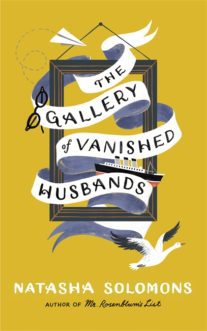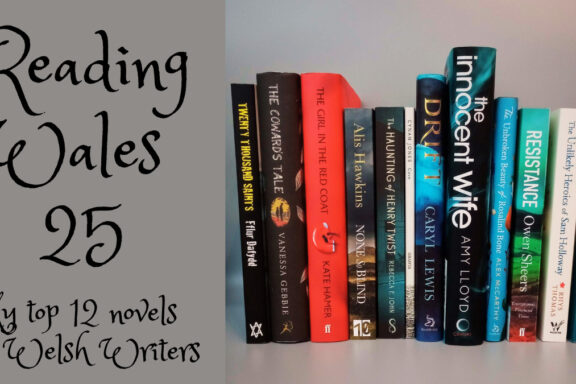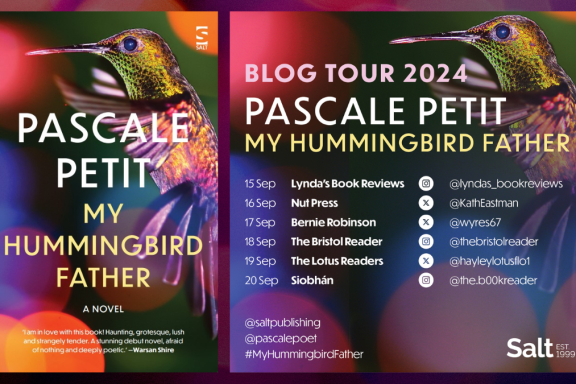 One of the best things about reading novels is how they can take you into new worlds. The world of any book is, of course, always its author’s creation, whether it be rooted in truth, or based on a skewed version of the world we know, or one entirely of the author’s own imagining but what I mean here is that some of the books I enjoy the most are the ones that introduce me to a world I either know nothing or very little about. And so it is with Natasha Solomons’ third novel, The Gallery of Vanished Husbands.
One of the best things about reading novels is how they can take you into new worlds. The world of any book is, of course, always its author’s creation, whether it be rooted in truth, or based on a skewed version of the world we know, or one entirely of the author’s own imagining but what I mean here is that some of the books I enjoy the most are the ones that introduce me to a world I either know nothing or very little about. And so it is with Natasha Solomons’ third novel, The Gallery of Vanished Husbands.
The Gallery of Vanished Husbands is set in two very different and often conflicting worlds: the conservative Jewish community in which the main character, Juliet Montague, is brought up and the art world of 1960s London which she falls into but then manages to carve out a role for herself.
What makes this novel so interesting initially are Juliet’s personal circumstances. Her husband, George, has left her and their two young children and because he simply vanishes one day, she becomes what is known as an ‘aguna’. This means that she remains legally married but without a husband and that her husband can’t be reached for whatever reason in order for her to obtain a divorce. Since George has disappeared and left no clues as to where he might have gone, she’s likely to remain in this unsatisfactory state of limbo for some time and is effectively a social pariah. The Jewish community she’s a part of would like Juliet to live quietly and not attract attention to herself, (until her husband hopefully returns but indefinitely if he doesn’t) and her parents want her to do the same, while also working for the family business.
However, when George left, he took with him a portrait of Juliet as a young girl and she is so incensed by its loss that you feel like he’s stolen a part of her. Which in a way he has, not only by taking something of hers of great sentimental value, but also because what he’s taken is an image of her. He’s left her hanging (in place of the picture?) by not breaking his legal ties with her and divorcing her. Juliet’s reaction to the loss of the painting told me she wasn’t the sort of woman to settle for such a subdued and unfulfilling life as the one her parents and the wider conservative community wishes her to live.
Juliet tries to do what is expected of her but a trip to London to purchase her very first fridge, which she’s saved long and hard for, makes her life take a decided turn. For it’s here that she runs into Charlie Fussell, a young artist displaying some of his work on park railings, and it’s here that she decides to spend the money she’s scrimped and saved on a new portrait of herself instead. Through Charlie, she meets other artists and falls into the London art scene and sets about creating a new life for herself and her children.
Each chapter in the book begins with the description of a painting of Juliet and it’s fascinating to see how these then come about and how they chart a stage of her new life. I enjoyed having these as markers throughout the novel and looked forward to seeing what each new painting would signify in Juliet’s life, and how she was growing emotionally, while always being aware that that first painting of her was still ‘missing’ from this new collection she was building up. That missing piece will take her and her children from London to California on a quest to find not only that first painting but the husband who stole it.
This is a fascinating story about a truly remarkable and unusual woman – how could she be anything less with a name like Juliet Montague? She’s a woman who not only falls outside her own society’s narrow norms but also challenges those in the wider, more liberal, society she moves in. (It’s important to remember that it was a society where the Pill was only available to married women and the sexual revolution was still in its early stages.) Juliet is by no means perfect but I liked her all the more for being flawed. It’s what makes her human and believable as a character. She may be attractive or, at least, she has the type of face that artists want to paint and she certainly attracts people around her; she’s bold, brave and hard-working, but she also makes mistakes and I did sometimes have to question if the new life she was making for herself was also the best one for her two children, an issue that’s reflected by the impact her new life has on them and their differing reactions to it. But most of all, I wanted Juliet to win through because I hated how restrictive her life could have been and loved how she refused to quietly accept her fate but instead chose to seize life and follow her passions.
The Gallery of Vanished Husbands is a wonderfully warm and touching novel about one woman’s emphatic refusal to accept the position she’s left in or put in by others and the passionate claim she stakes on a very different life for herself. It’s about a woman who refuses to hide away and live quietly, no matter how much society wishes it. It’s about a woman who insists upon being seen and being present in her everyday life, rather than solely existing in the portraits capturing moments in her life. And, above all, it’s about saying Yes! to life. I thoroughly enjoyed reading The Gallery of Vanished Husbands and am very much looking forward to seeing where Natasha Solomons will take me in her next book.
The Gallery of Vanished Husbands is Natasha Solomons’ third novel and is published by Sceptre. It is available from Amazon UK, Amazon US, The Book Depository and Waterstones. You can find out more about Natasha Solomons and her books on her publisher’s Author Page or from her own Author Website.



I bought this one a few weeks ago, and am looking forward to it – I loved her second novel. Happy Christmas Kath! x
I think you’ll enjoy this one, too. I’m sure you will. Merry Christmas, Lins! x